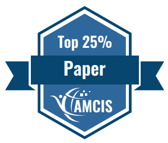Virtual Communities and Collaboration
Loading...
Paper Type
Complete
Paper Number
1436
Description
Tools are commonly utilized by distributed agile software development teams to support communication and collaboration. However, few studies have systematically unpacked the affordances of such tools. Moreover, with the rise of COVID-19 in 2020, teams are faced with new dynamics and challenges that are not addressed by traditional remote work literature. Building on affordance theory, this study explores how teams can actualize tools affordances to support communication and collaboration during COVID-19 remote work. The chosen method is an in-depth case study of a distributed agile software development team, with data being collected using semi-structured interviews. The paper outlines 25 perceived affordances which were exploited from the various features of 10 tools. These affordances were actualized by the teams, resulting in 4 outcomes: Fostering of Engagement, Streamlined Communication, Enhanced Virtual Meetings and Increased Shared Understanding. The outcomes supported communication and collaboration during COVID-19 remote work.
Recommended Citation
Tanner, Maureen and Naidoo, Mageshen, "The Use of Tools Affordances to Support Communication and Collaboration during COVID-19 remote work" (2021). AMCIS 2021 Proceedings. 8.
https://aisel.aisnet.org/amcis2021/virtual_communities/virtual_communities/8
The Use of Tools Affordances to Support Communication and Collaboration during COVID-19 remote work
Tools are commonly utilized by distributed agile software development teams to support communication and collaboration. However, few studies have systematically unpacked the affordances of such tools. Moreover, with the rise of COVID-19 in 2020, teams are faced with new dynamics and challenges that are not addressed by traditional remote work literature. Building on affordance theory, this study explores how teams can actualize tools affordances to support communication and collaboration during COVID-19 remote work. The chosen method is an in-depth case study of a distributed agile software development team, with data being collected using semi-structured interviews. The paper outlines 25 perceived affordances which were exploited from the various features of 10 tools. These affordances were actualized by the teams, resulting in 4 outcomes: Fostering of Engagement, Streamlined Communication, Enhanced Virtual Meetings and Increased Shared Understanding. The outcomes supported communication and collaboration during COVID-19 remote work.
When commenting on articles, please be friendly, welcoming, respectful and abide by the AIS eLibrary Discussion Thread Code of Conduct posted here.



